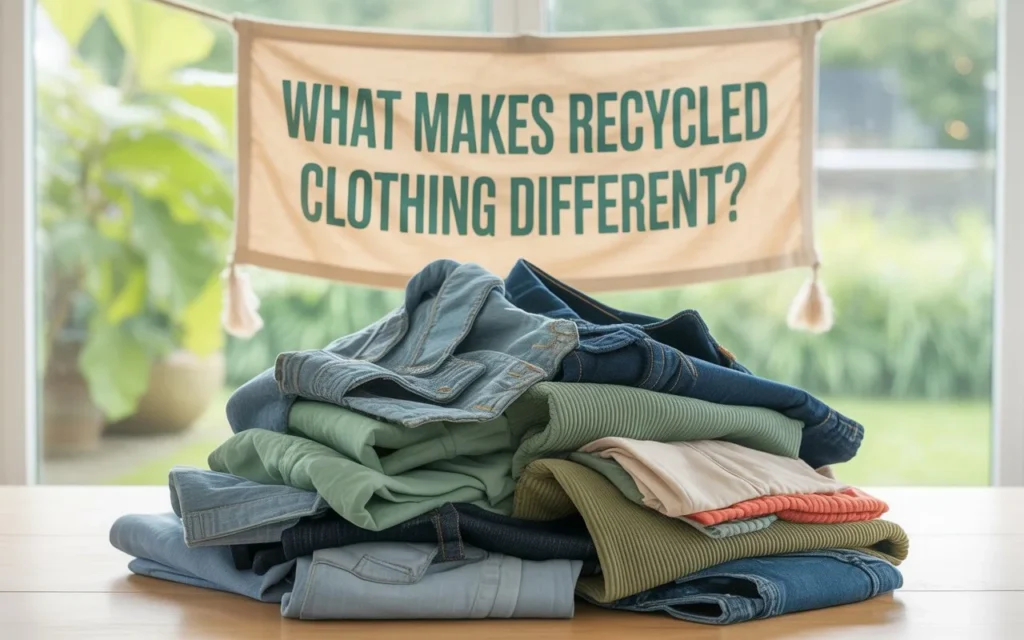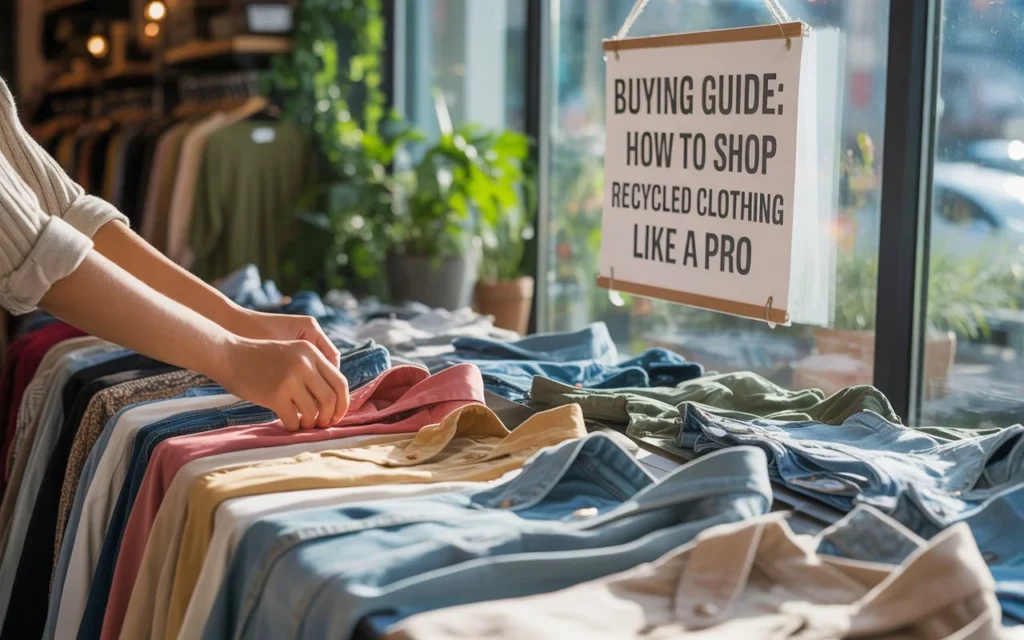Fast fashion has a dirty secret—it leaves mountains of waste behind. But a new wave of designers, brands, and consumers is turning that waste into style. Recycled clothing is proving that fashion can be both attractive and responsible, transforming cast-off fabrics, worn garments, and even plastic bottles into fresh, high-quality pieces.
At Eco Gear Guides, we see recycled fashion as more than a trend—it’s a pathway toward a cleaner, smarter wardrobe for the modern consumer.
What Makes Recycled Clothing Different?

Recycled clothing isn’t about hand-me-downs—it’s about innovation. Old textiles are broken down into fibers, cleaned, spun into new yarn, and then rewoven into fabrics that are ready for modern designs. In some cases, the source material isn’t even clothing—it could be fishing nets, carpet fibers, or discarded plastic bottles.
Two main streams fuel this process:
- Post-consumer waste – worn clothing collected from donation bins or take-back programs, reprocessed into fresh fabrics.
- Pre-consumer waste – unused factory scraps and offcuts that never made it to store shelves but are given a second chance.
Why Choose Recycled Clothing?
1. A Direct Hit Against Fashion Waste
Every year, millions of garments end up in landfills, many of them still in wearable condition. Recycling keeps valuable materials in the system instead of burying them.
Example: Outerknown creates jackets from old fishing nets, cutting both ocean pollution and textile waste.
2. Serious Resource Savings
The difference in water, energy, and raw material use between virgin fabrics and recycled fabrics is huge.
| Material | Water Use (Virgin) | Water Use (Recycled) |
|---|---|---|
| Cotton | ~2,700 liters per shirt | Up to 90% less |
| Polyester | Energy-heavy from oil | 60–70% less energy |
3. Smaller Carbon Footprint
Fewer raw materials mean fewer greenhouse gas emissions—recycled fabrics can cut carbon output by up to 40%.
4. Building a Circular Fashion Model
Recycled clothing supports the idea that nothing in fashion should be “single-use.” Materials should circulate, not end up as waste.
Brands That Are Doing It Right
1. Patagonia
Turns old garments and plastic bottles into outdoor clothing, backed by repair programs to extend product life.
2. Girlfriend Collective
Makes colorful activewear from post-consumer plastics, proving performance gear can be planet-friendly.
3. Tentree
Every item plants ten trees and uses a mix of recycled polyester and sustainable fibers.
4. Ecoalf
Transforms abandoned fishing nets and ocean debris into modern apparel and footwear.
5. Levi’s Water<Less
Reduces water use and incorporates recycled cotton into its iconic denim.
Eco Gear Guides Note: Trust comes from transparency—look for brands that share their sourcing and recycling processes openly.
Buying Guide: How to Shop Recycled Clothing Like a Pro

1. Read the Label—Carefully
Check for the exact percentage of recycled content. “Eco-friendly” doesn’t always mean recycled.
2. Verify with Certifications
Labels like Global Recycled Standard (GRS) and Recycled Claim Standard (RCS) ensure the fabric really is recycled.
3. Think About the Long Game
A $120 recycled winter coat that lasts seven years is better value than a $40 fast-fashion option that wears out in one season.
4. Go Local When You Can
Local recycled clothing cuts shipping emissions and supports community makers.
Read More : Biodegradable vs Recyclable Electronics: What to Choose?
Benefits and Drawbacks at a Glance
| Benefits | Drawbacks |
|---|---|
| Saves water, energy, and raw materials | Often costs more upfront |
| Reduces textile and plastic waste | Limited style range in some areas |
| Supports ethical, sustainable brands | Requires some research |
| Often more durable and long-lasting | Blended fabrics may still need virgin fibers |
Real-Life Example: Fashion with an Impact
In 2024, a small workshop in Lahore began collecting worn denim from donation drives. The fabric was shredded, blended with recycled PET bottle fibers, and sewn into durable work jackets. In just nine months, over 65,000 bottles were diverted from waste streams, and dozens of local tailors gained stable income.
Eco Gear Guides’ Starter Picks for Recycled Clothing
- Recycled Polyester Fleece – Cozy warmth from repurposed plastic bottles.
- Recycled Cotton Basics – Everyday shirts with a smaller footprint.
- Performance Leggings – Flexible and made from reclaimed synthetics.
- Upcycled Denim Jacket – A classic with a second life.
Conclusion
Recycled clothing is proof that fashion can evolve beyond wasteful trends. Every recycled garment is a quiet act of environmental activism—cutting waste, conserving resources, and supporting brands that do better.
At Eco Gear Guides, we believe that style and sustainability aren’t opposites—they’re partners in shaping a better fashion future.
Read More : The Ultimate Guide to Zero Waste Grocery Shopping
FAQs
Does recycled clothing feel different?
Not usually—modern recycling technology makes fabrics just as soft and durable as virgin materials.
Why is it more expensive?
The process is more complex, but the garments often last longer, making them cost-effective.
Can all clothes be recycled?
Mixed-fiber garments are harder to recycle, but innovations are making it possible.
Is upcycling the same thing?
No—upcycling creatively reuses whole garments; recycling turns them into new fibers.
Where can I recycle my clothes?
Many brands offer take-back programs, and local recycling centers may accept textiles.


